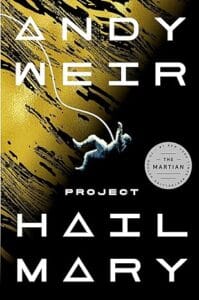This book brings me joy! It masterfully blends two of my favourite interests: optics and science fiction.
In Project Hail Mary, we follow Ryland, a man who wakes up on a spaceship with no memory of who he is or how he got there. He faces an even bigger challenge: he holds the fate of all human civilization in his hands.
And everyone else on the ship is dead…
One thing that really stuck out to me was the “mess around and find out” scenes. Ryland is always diving into new and unfamiliar challenges, which makes his character more interesting. It’s fun to see how, when something works right off the bat, it usually leads to some unexpected twists. This makes for a narrative that keeps readers on their toes.
And the science is true: yes, it is fiction — but it does make total sense.
Reading well-crafted science fiction is like exploring a carefully constructed maze. Just as a maze has defined paths and clear boundaries that guide you to the exit, good science fiction adheres to the laws of physics and reality. It allows readers to navigate through imaginative scenarios while still holding onto a logical framework, making the journey both thrilling and grounded.
“But after a few months, the Petrovascope won’t be able to see the light anymore. Not because the light is too dim—it’s a very sensitive instrument. It won’t be able to see him because our relative velocities will cause a red-shift in the light coming off his drives. It won’t be the Petrova wavelength anymore when it gets to me.”
The story unfolds in two alternating timelines. One timeline is set in the present day, where Ryland is figuring out his situation and determining what actions to take. The other timeline consists of a series of flashbacks that lead up to his mission.
Crafting a story with two timelines is risky business. It requires a delicate equilibrium to weave both narratives together seamlessly, but Andy Weir managed to tackle this extremely well. The flashback timeline flows smoothly alongside the main storyline, enhancing it rather than disrupting it. Also, the secondary timeline brought to life a diverse cast of intriguing characters, adding depth and richness to the overall narrative.
First contact with aliens has always been such an interesting and naturally engaging idea in sci-fi, and it seems that Andy Weir completely understands how to pull that off successfully. What intrigued me the most is that he takes a totally different approach from the usual ways aliens are portrayed. Instead of going with the typical image of what an alien might be like, he brings something fresh and unexpected to the table.
There are two big questions in the whole realm of “first alien contact”:
- Why are we unable to make contact with aliens?
- Why haven’t they contacted us?
One interesting theory that Andy Weir discusses is that either the aliens are not interested in us, or their level of intelligence is not sufficient to reach out. For example, consider why you wouldn’t go to the Amazon rainforest just to see some unique ants that are only native to that area. You know they exist, but it doesn’t make sense to make the effort. The point is that we’re likely to encounter life forms that possess intelligence akin to our own.
The interactions between the characters are truly invaluable, especially in the present timeline. Watching how they observe one another, each trying to decode the other’s thoughts and intentions, is endlessly fascinating. Their attempts to communicate are not only intriguing but also downright hilarious.
When considering the downsides, one thing to keep in mind is that some readers may find the scientific details a bit overwhelming. Personally, I really enjoy the scientific aspects — they make the story feel more realistic. However, I’ve seen complaints about The Martian in the past, with some people feeling there was too much focus on science. Even though I haven’t read it myself, I can understand why some folks might not want to delve too deeply into the scientific details while reading. This makes sense because I’ve struggled to grasp the biological science sections in the book.
There is a common and fairly simple structure shared by all successful stories, whether in books, movies, or other art forms. This structure is most effective when it isn’t overly emphasized. While there may be intriguing elements throughout the middle of the story, the main element that captures people’s hearts remains the same in almost every beloved narrative.
This book tells the story of a man who transformed his personality to become a better person.
This is a story about a man who initially avoids responsibility, even with the world’s fate at stake. But something happens, and then he embraces his role, deciding to fight not just for his own species but also for another he has recently come to know.
“Okay, if I’m going to die, it’s going to have meaning. I’m going to figure out what can be done to stop Astrophage. And then I’ll send my answers off to Earth. And then … I’ll die.”
And, like always, that premise works…
Other Quotes From the Book
“What if Eridians have a life-span of 2 million years and waiting a century to reply is considered polite?”
“Intelligence evolves to give us an advantage over the other animals on our planet. But evolution is lazy. Once a problem is solved, the trait stops evolving. So you and me, we’re both just intelligent enough to be smarter than our planet’s other animals.”
“Broadly speaking, the human brain is a collection of software hacks compiled into a single, somehow-functional unit. Each ‘feature’ was added as a random mutation that solved some specific problem to increase our odds of survival.”

